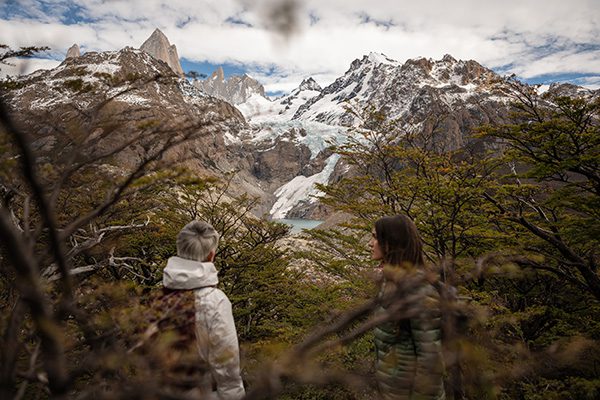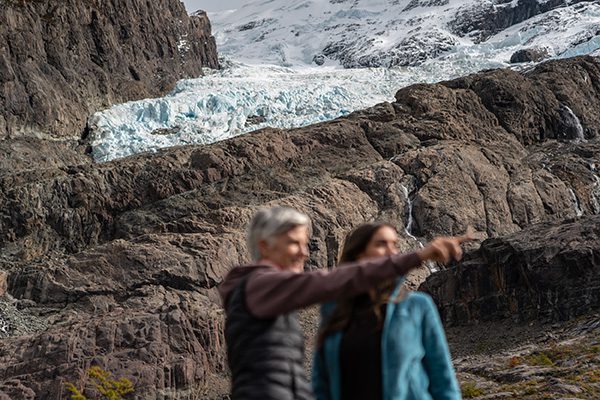The glaciers of El Chaltén: the frozen wonderland of Argentinean Patagonia
Crowning the magnificent mountains and towering over the turquoise lakes of the Argentinean town of El Chaltén, lie a wealth of glaciers rich in beauty, history and ecological significance. In the Los Glaciares National Park there are 48 expansive glaciers to discover and over 100 smaller ones. All of them are located within the Southern Patagonian Ice Field. Although they have been in constant decline since the 1970s, today more than ever, it is vital that the role these glaciers play in sustaining life on our planet is more widely understood. Here we provide you with more details.

Located in the northern region of Los Glaciares National Park, in the province of Santa Cruz, Argentina, El Chaltén attracts hoards of travelers every year with the promise of trekking, hiking and climbing in the wildest of landscapes. It is no coincidence it is referred to as the Trekking Capital of Argentina.
The infamous Mount Fitz Roy and Cerro Torre towers are arguably the most dramatic sights. Yet the tapestry of lakes, forests and and fauna such as the rare huemul (Hippocamelus bisulcus) are all dependent upon the area´s glacier network. This network and can be accessed from the Argentinean frontier-style town of El Chaltén.
Icefield time capsule
Experiencing a glacier up close and personal is something that every traveller should seek out. From El Chaltén you can witness these incredible masses of ice. The glaciers are located at an average altitude of 1500 metres which makes them easily observable and accessible; always when appropriate safety precautions are taken.

The snowdrifts and glaciers in the El Chaltén area are fed by the Southern Patagonian Ice Field, also known as The Southern Icefields or The Patagonian Continental Icefield. The Andes mountain range in this area of Patagonia is largely submerged beneath this 12,363 km2 expanse of ice, with only the tallest peaks emerging out of it. The Southern Patagonian Ice Field straddles both Argentina and Chile and is considered the third largest area of ice in the world after Antarctica and Greenland. It is the second largest freshwater reserve on the planet.
Glaciers, as the geologist Eduardo Malagnino explains, are bodies of snow and ice that were formed thanks to the accumulation, compaction and recrystallization of snow, forming a body of ice that, in the case of the Southern Patagonian Ice Field, has been present since the Last Glacial Maximum approximately 20,000 years ago and as part of a glaciation process that dates back to the late Miocene.

Several million years later after they took form, various historical characters such as Captain Juan Fernández Ladrillero, Antonio Viedma, Alberto Agostini and Francisco Perito Moreno, among other adventurers created travelogues and accounts of their adventurers in the icefield. Ancient indigenous legends, nevertheless, predate all of these.
In 1937 the Argentinean government created the Los Glaciares National Park at a nexus point where glaciers of the Southern Patagonian Ice Field, numerous forests and iconic mountains converge. Furthermore, in 1981, the United Nations Organization (UNESCO) declared the area a World Heritage Site.
The big must-sees
The horizon in El Chaltén is full of rock, mountains and ice, tempting adventurers out on the trails past lagoons and towards the glaciers. When tourism was developed in El Chaltén, the possibility to use it as a spring-board to launch tourists, travelers and nature lovers into the heart of the Patagonian wilderness was front of mind.
Just 131 kilometers from El Chaltén is the renowned 258 km2 Perito Moreno Glacier. This tongue-shaped valley glacier is a true beauty. In 2023 Condé Nast Traveler magazine recognized it as one of the seven wonders of the world of 2023, describing it as a powerful and dazzling place, where carving icebergs thunder as they plunge into the water below.

Close to El Chaltén is the incredible 902 km2 Upsala Glacier; a sea of comparative stability and silence. 53.7km in length, its icy tendrils stretch into the turquoise Lake Argentina, one of the largest lakes in Patagonia.
Just 28 kilometers from the National Trekking Capital of Argentina, is the impressive 978 km2 Viedma Glacier. At 70km in length, it is the longest glacier in South America. This ice giant is born on the Lautaro volcano and stretches between the mountains Huemul and Campana before reaching the deep Lake Viedma. Lake Viedma is the longest lake in Argentina. It is formed by glacial abrasion and is well worth a visit.
“When I went to the Viedma glacier for the first time,” Camilo Rada explains, “I encountered large rivers that flow over the top of its ice. At the time, I had no idea that this phenomenon known as supraglacial rivers existed. It is simply fascinating.” Rada is a glaciologist, researcher and academic at the University of Magallanes.

Another key site to visit near El Chaltén is the Huemul lagoon, fed by the Huemul Glacier. It is characterized by impressive waterfalls and spectacular views. Alternatively, the Torre lagoon and the incredible Torre Glacier and iconic Cerro Torre are big draws. However, if simply stunning landscapes are your main focusa, the Laguna Azul and Laguna del Diablo with the amazing Cagliero glacier are must visits.
Another must-see is the the very beautiful Vespignani Glacier, located near the Las Vueltas River, between Desert Lake and Laguna Huemul. It is reached via a marvelous and unforgettable hike from El Chaltén. There are many other glaciers in the area to visit too.

A fragile and vital source of water
Currently glaciers are retreating, partly due to natural processes but also due to man-made climate change. In the last 50 years the world’s glaciers have lost almost 10 billion tons of ice.
“Since the 20th century,” Rada explains, “the rate of retreat has accelerated. These large masses of ice are no longer retreating gradually in a regimented stepped way; instead they are retreating in leaps and jumps. Had anthropogenic warming not occurred, perhaps, the glaciers would have taken until the year 2100 to have retreated to the state we now find them in.”
Experts explain that some glaciers can weather a warming planet for a longer period of time. Geography plays a fundamental role in ensuring their longevity. The Torre Glaciar began experiencing an accelerated rate of warming once it moved away from the geographical barrier that protected it.
“They are all in a worrying state,” Rada explains of the glaciers. “But the most worrying one is the Viedma Glacier, due to its size and its outsized rate of retreat. Glaciers are the ice runways that act as outlets from the Southern Patagonian Ice Field. The problem is, they are running away faster than they should.”
Since glaciers are going to melt no matter what we do to prevent it, the urgent challenge is to try to make this melting process as slow as possible. It is vital that human beings and biodiversity as a whole have a chance to adapt to these changes.
“All glaciers,” Rada adds, “are important in their capacity to act as water reserves; for their effect on the climate, as well as topping up river levels and preventing sea level rise. When glaciers melt, it is lost to the seas, causing the water level to rise. El Chaltén´s glaciers have a unique touristic role to play that is not seen with remoter glaciers. Accessing these glaciers is how people come to learn what is happening to our glaciers and also witness what is happening to our planet at large.”

